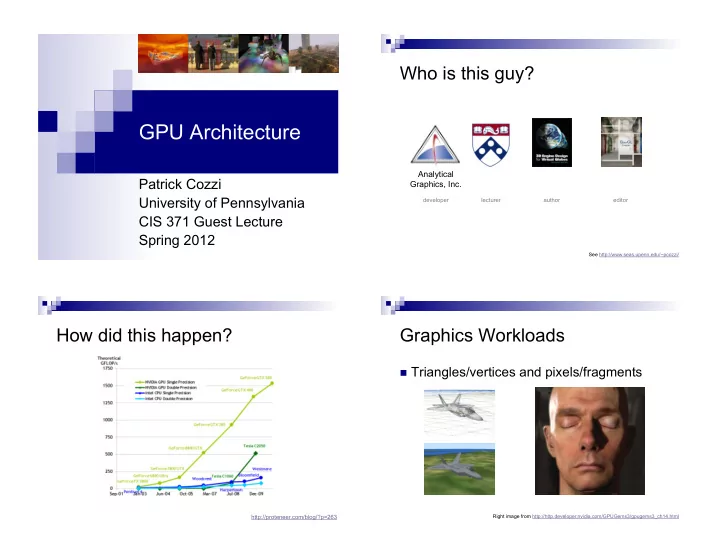

Who is this guy? GPU Architecture Analytical Patrick Cozzi Graphics, Inc. University of Pennsylvania developer lecturer author editor CIS 371 Guest Lecture Spring 2012 See http://www.seas.upenn.edu/~pcozzi/ How did this happen? Graphics Workloads Triangles/vertices and pixels/fragments http://proteneer.com/blog/?p=263 Right image from http://http.developer.nvidia.com/GPUGems3/gpugems3_ch14.html
Early 90s – Pre GPU Why GPUs? Graphics workloads are embarrassingly parallel Data-parallel Pipeline-parallel CPU and GPU execute in parallel Hardware: texture filtering, rasterization, etc. Slide from http://s09.idav.ucdavis.edu/talks/01-BPS-SIGGRAPH09-mhouston.pdf Data Parallel NVIDIA GeForce 6 (2004) 6 vertex shader processors Beyond Graphics Cloth simulation Particle system Matrix multiply 16 fragment shader processors Image from: https://plus.google.com/u/0/photos/100838748547881402137/albums/5407605084626995217/5581900335460078306 Image from http://http.developer.nvidia.com/GPUGems2/gpugems2_chapter30.html
NVIDIA G80 Architecture Why Unify Shader Processors? Slide from http://s08.idav.ucdavis.edu/luebke-nvidia-gpu-architecture.pdf Slide from http://s08.idav.ucdavis.edu/luebke-nvidia-gpu-architecture.pdf Why Unify Shader Processors? GPU Architecture Big Ideas GPUs are specialized for Compute-intensive, highly parallel computation Graphics is just the beginning. Transistors are devoted to: Processing Not: Data caching Flow control Slide from http://s08.idav.ucdavis.edu/luebke-nvidia-gpu-architecture.pdf
Slide from: http://bps10.idav.ucdavis.edu/talks/03-fatahalian_gpuArchTeraflop_BPS_SIGGRAPH2010.pdf Slide from: http://bps10.idav.ucdavis.edu/talks/03-fatahalian_gpuArchTeraflop_BPS_SIGGRAPH2010.pdf Slide from: http://bps10.idav.ucdavis.edu/talks/03-fatahalian_gpuArchTeraflop_BPS_SIGGRAPH2010.pdf Slide from: http://bps10.idav.ucdavis.edu/talks/03-fatahalian_gpuArchTeraflop_BPS_SIGGRAPH2010.pdf
Slide from: http://bps10.idav.ucdavis.edu/talks/03-fatahalian_gpuArchTeraflop_BPS_SIGGRAPH2010.pdf Slide from: http://bps10.idav.ucdavis.edu/talks/03-fatahalian_gpuArchTeraflop_BPS_SIGGRAPH2010.pdf Slide from: http://bps10.idav.ucdavis.edu/talks/03-fatahalian_gpuArchTeraflop_BPS_SIGGRAPH2010.pdf Slide from: http://bps10.idav.ucdavis.edu/talks/03-fatahalian_gpuArchTeraflop_BPS_SIGGRAPH2010.pdf
Slide from: http://bps10.idav.ucdavis.edu/talks/03-fatahalian_gpuArchTeraflop_BPS_SIGGRAPH2010.pdf Slide from: http://bps10.idav.ucdavis.edu/talks/03-fatahalian_gpuArchTeraflop_BPS_SIGGRAPH2010.pdf Slide from: http://bps10.idav.ucdavis.edu/talks/03-fatahalian_gpuArchTeraflop_BPS_SIGGRAPH2010.pdf Slide from: http://bps10.idav.ucdavis.edu/talks/03-fatahalian_gpuArchTeraflop_BPS_SIGGRAPH2010.pdf
NVIDIA G80 Slide from: http://bps10.idav.ucdavis.edu/talks/03-fatahalian_gpuArchTeraflop_BPS_SIGGRAPH2010.pdf NVIDIA G80 NVIDIA G80 Streaming Processing (SP) Streaming Multi-Processor (SM)
NVIDIA G80 NVIDIA GT200 16 SMs 30 SMs Each with 8 SPs Each with 8 SPs 128 total SPs 240 total SPs Each SM hosts up Each SM hosts to 768 threads up to 1024 threads Up to 12,288 threads in flight In flight, up to 30,720 threads Slide from David Luebke: http://s08.idav.ucdavis.edu/luebke-nvidia-gpu-architecture.pdf Slide from David Luebke: http://s08.idav.ucdavis.edu/luebke-nvidia-gpu-architecture.pdf GPU Computing History 2001/2002 – researchers see GPU as data- Let’s program parallel coprocessor The GPGPU field is born this thing! 2007 – NVIDIA releases CUDA CUDA – Compute Uniform Device Architecture GPGPU shifts to GPU Computing 2008 – Khronos releases OpenCL specification
CUDA Abstractions CUDA Kernels A hierarchy of thread groups Executed N times in parallel by N different Shared memories CUDA threads Barrier synchronization Thread ID Declaration Specifier Execution Configuration CUDA Program Execution Thread Hierarchies Grid – one or more thread blocks 1D or 2D Block – array of threads 1D, 2D, or 3D Each block in a grid has the same number of threads Each thread in a block can Synchronize Access shared memory Image from: http://courses.engr.illinois.edu/ece498/al/textbook/Chapter2-CudaProgrammingModel.pdf
Thread Hierarchies Thread Hierarchies Thread Block Group of threads G80 and GT200: Up to 512 threads Fermi: Up to 1024 threads Reside on same processor core Share memory of that core Image from: http://courses.engr.illinois.edu/ece498/al/textbook/Chapter2-CudaProgrammingModel.pdf Image from: http://courses.engr.illinois.edu/ece498/al/textbook/Chapter2-CudaProgrammingModel.pdf Thread Hierarchies Thread Hierarchies Threads in a block Share (limited) low-latency memory Synchronize execution To coordinate memory accesses __syncThreads() Barrier – threads in block wait until all threads reach this Lightweight Image from: http://developer.download.nvidia.com/compute/cuda/3_2_prod/toolkit/docs/CUDA_C_Programming_Guide.pdf Image from: http://courses.engr.illinois.edu/ece498/al/textbook/Chapter2-CudaProgrammingModel.pdf
Scheduling Threads Scheduling Threads Warp – threads from a block Warps for three blocks scheduled G80 / GT200 – 32 threads on the same SM. Run on the same SM Unit of thread scheduling Consecutive threadIdx values An implementation detail – in theory warpSize Image from: http://courses.engr.illinois.edu/ece498/al/textbook/Chapter3-CudaThreadingModel.pdf Scheduling Threads Scheduling Threads Remember this: Image from: http://bps10.idav.ucdavis.edu/talks/03-fatahalian_gpuArchTeraflop_BPS_SIGGRAPH2010.pdf Slide from: http://courses.engr.illinois.edu/ece498/al/Syllabus.html
Scheduling Threads Scheduling Threads What happens if branches in a warp Remember this: diverge? Image from: http://bps10.idav.ucdavis.edu/talks/03-fatahalian_gpuArchTeraflop_BPS_SIGGRAPH2010.pdf Scheduling Threads Scheduling Threads 32 threads per warp but 8 SPs per 32 threads per warp but 8 SPs per SM. What gives? SM. What gives? When an SM schedules a warp: Its instruction is ready 8 threads enter the SPs on the 1 st cycle 8 more on the 2 nd , 3 rd , and 4 th cycles Therefore, 4 cycles are required to dispatch a warp
Scheduling Threads Scheduling Threads Question Solution A kernel has Each warp has 4 multiples/adds 1 global memory read ( 200 cycles) 16 cycles 4 non-dependent multiples/adds We need to cover 200 cycles How many warps are required to hide the 200 / 16 = 12.5 memory latency? ceil(12.5) = 13 13 warps are required Memory Model Thread Synchronization Recall: Threads in a block can synchronize call __syncthreads to create a barrier A thread waits at this call until all threads in the block reach it, then all threads continue Mds[i] = Md[j]; __syncthreads(); func(Mds[i], Mds[i + 1]); Image from: http://courses.engr.illinois.edu/ece498/al/textbook/Chapter2-CudaProgrammingModel.pdf
Thread Synchronization Thread Synchronization Thread 0 Thread 1 Thread 0 Thread 1 Mds[i] = Md[j]; Mds[i] = Md[j]; Mds[i] = Md[j]; Mds[i] = Md[j]; __syncthreads(); __syncthreads(); __syncthreads(); __syncthreads(); func(Mds[i], Mds[i+1]); func(Mds[i], Mds[i+1]); func(Mds[i], Mds[i+1]); func(Mds[i], Mds[i+1]); Thread 2 Thread 3 Thread 2 Thread 3 Mds[i] = Md[j]; Mds[i] = Md[j]; Mds[i] = Md[j]; Mds[i] = Md[j]; __syncthreads(); __syncthreads(); __syncthreads(); __syncthreads(); func(Mds[i], Mds[i+1]); func(Mds[i], Mds[i+1]); func(Mds[i], Mds[i+1]); func(Mds[i], Mds[i+1]); Time: 0 Time: 1 Thread Synchronization Thread Synchronization Thread 0 Thread 1 Thread 0 Thread 1 Mds[i] = Md[j]; Mds[i] = Md[j]; Mds[i] = Md[j]; Mds[i] = Md[j]; __syncthreads(); __syncthreads(); __syncthreads(); __syncthreads(); func(Mds[i], Mds[i+1]); func(Mds[i], Mds[i+1]); func(Mds[i], Mds[i+1]); func(Mds[i], Mds[i+1]); Thread 2 Thread 3 Thread 2 Thread 3 Mds[i] = Md[j]; Mds[i] = Md[j]; Mds[i] = Md[j]; Mds[i] = Md[j]; __syncthreads(); __syncthreads(); __syncthreads(); __syncthreads(); func(Mds[i], Mds[i+1]); func(Mds[i], Mds[i+1]); func(Mds[i], Mds[i+1]); func(Mds[i], Mds[i+1]); Threads 0 and 1 are blocked at barrier Time: 1 Time: 2
Recommend
More recommend